|
Thursday, March 10
- Breakfast: Apple sticks
- Southwestern chicken tortilla
- Philly-style cheese steak
- *Garlic herb roasted pork
- Mardi gras jambalaya
- Southwestern turkey wrap
- Assorted sliced pizza
- Marinated grilled chicken caesar salad
*carb-restricted alternative
Wilson Hall Cafe Menu |
|
Friday, March 11
Dinner
- Pasta carbonara
- stuffed filet of sole with crabmeat
- Sautéed spinach with lemon and garlic
- Pecan rum cake
Wednesday, March 16
Lunch
- Bourbon glazed salmon
- Brown rice medley
- Steamed broccoli
- Cold lemon soufflé/butter cookies
Chez Leon Menu
Call x3524 to make your reservation.
|
|
Tumbling opens possibilities
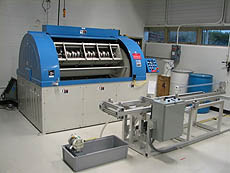 |
|
The tumbling machine (left) can holds accelerating cavities, rotating them up to 115 turns per minute. The rinsing device (right) washes the media out. |
Spatterings, pits, defects in weld beads – these are the thorns in the sides of many a newly minted accelerator cavity, marring their interior walls and getting in the way of healthy accelerating gradients.
Scientists at Fermilab are testing a new method of removing these blemishes from superconducting radiofrequency cavities. It's called centrifugal barrel polishing, and the team hopes it will yield a consistently reproducible mirror-like finish, and so consistent cavity performance.
“What we're doing is similar to the process of polishing gemstones,” said Fermilab's SRF Materials Group Leader Lance Cooley. “We're making shiny jewels.”
Of course, with niobium cavities, the purpose is not to turn the cavity's inner wall into shimmering eye candy. The fewer surface imperfections inside the cavity, the more easily a particle beam will accelerate from one end of the cavity to the other.
Charlie Cooper proposed the method – known more familiarly as tumbling – as a potential cavity-polishing method at Fermilab. He has been testing various fine-polishing procedures over the last year. Approaching cavity-polishing from a metallographic standpoint, he set out to develop a process that would be environmentally friendly, safe and repeatable.
Read more
-- Leah Hesla
|
Fermilab Wonders of Science Show takes place March 27
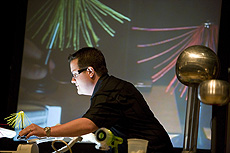 |
|
Karl Craddock, a teacher from Fremd High School in Palatine, demonstrates effects of static electricity at the 2010 Wonders of Science show.
|
High school teachers will take science out of the textbook and put it into children’s hands at Fermilab’s annual Wonders of Science event.
“The show is an excellent opportunity for families to share a fun time together while learning about science,” said Nancy Lanning of the Fermilab Education Office.
On Sunday, March 27, from 1–2 p.m., award-winning high school teachers will perform fast-paced demonstrations on chemical and physical phenomena. Portions of the 24-year-old event have appeared on TV shows such as “Late Show with David Letterman”, “Inside Edition” and “CBS News.”
“This is one of our most exciting events every year,” said Spencer Pasero, an education program leader at Fermilab. “Everyone has their favorite demonstration, but there is always something new and exciting to look forward to.”
This year’s performance, which will have a light and color theme, will feature “Weird Science,” a group of current and retired high school teachers who have been recognized locally and nationally for their ability to engage young minds. That group includes Lee Marek of the University of Illinois at Chicago (formerly of Naperville North High school), Karl Craddock of Fremd High School in Palatine, and Bill Grosser of Oak Park-River Forest High School.
The program is designed for ages 7–12 and scout troops are welcome. Students will receive a science kit, which they can use to conduct their own experiments at home. Tickets are $4, and may be ordered using a printable registration form available here.
For additional information, contact Nancy Lanning.
Read the press release.
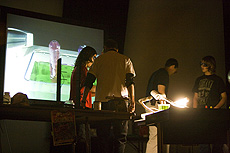 |
|
Lee Marek from the University of Illinois at Chicago and Bill Grosser from Oak Park-River Forest High School enlist the help of students for a demonstration at the 2010 Wonders of Science show. |
|
Astronomy on ice: IceCube from start to finish
With a detector encompassing a cubic kilometer of ice almost directly beneath the South Pole, IceCube is the world’s largest neutrino telescope. Like many other neutrino detectors, IceCube uses photomultiplier tubes to peer through a clear medium, looking for faint streaks of blue Cherenkov radiation – shockwaves from particles that are moving faster than light can travel in that medium. Most of what any such detector sees is background, but occasionally an energetic neutrino collides with an atomic nucleus and produces a muon headed in the same direction – the main quarry in the hunt for neutrinos from beyond the Sun.
Francis Halzen, a theoretical physicist at the University of Wisconsin-Madison and IceCube’s principal investigator, says his inspiration for the giant telescope came in the mid-1980s, while in Hawaii with other theorists plotting ways to find the top quark. A project named DUMAND (Deep Underwater Muon and Neutrino Detection) had been underway off the coast of the Big Island since 1976, and he got interested.
Read more.
|
|
Electroweak BuZZ
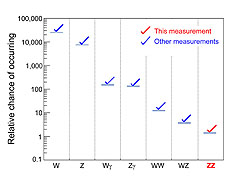 |
|
The production of two Z bosons in a single collision is among the rarest phenomena expected to occur at the Tevatron. It is about 20,000 times rarer than finding a single W boson. Exploiting the entire Run II DZero data set netted just 10 events of this kind.
|
The weak nuclear force is the weakest interaction that physicists at the Tevatron have successfully studied. Like all subatomic forces, we can understand it as being caused by the exchange of force carrying particles, specifically the W and Z bosons. These bosons were discovered in 1983, netting a quick Nobel Prize the following year.
The W and Z bosons are physical particles that are seen as a consequence of the unification of the weak and electromagnetic forces. The unification theory initially predicts that these force carriers are massless, but become massive by interacting with the hypothetical Higgs boson. So the study of the W and Z bosons is tied together with the Higgs search.
During the course of the following 25 years, physicists observed other interesting types of events containing W and Z bosons, each rarer than the ones before. In 2008, the DZero experiment observed the production of pairs of Z bosons. This phenomena is very rare; it’s about 20,000 times harder to produce pairs of Z bosons than it is to produce a single W boson.
Since the discovery, DZero has accumulated almost four times as much data and extended the analysis. To give a sense of the rarity of the phenomenon and difficulty of analysis, when the entire data set we’ve collected over the last eight years was exploited, we observed a grand total of ten particle collisions in which two Z bosons were created.
Ten is a small number, but it’s enough to start studying things in detail, including such things as the energy and direction of the Z bosons and their decay products. We even evaluated the data to see if there was evidence for a new type of particle produced that decayed into Z bosons.
The data was consistent with the Standard Model, which is bad news for people searching for new physical phenomena, but crucial input for our Higgs boson searches. You see, if the Higgs boson is heavy, it will decay into two Z bosons.
-- Don Lincoln
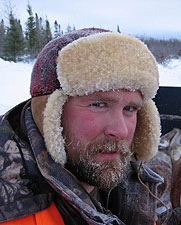 |
|
Ryan Hooper is affiliated with Brown University and Bradley University and performed this analysis.
|
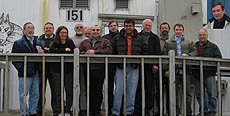 |
|
The muon detector operation team ensured that the DZero collaboration’s muon data was of high quality. Since Z bosons can decay into pairs of muons, this group directly contributed to this analysis. From left: Al Ito, Fermilab; ,Igor Churin, JINR; Penny Kasper, Fritz Bartlett, Yuri Yatsunenko, and Norik Khalatyan, Fermilab; Igor Vasilyev, IHEP; Amitabha Das, University of Arizona; Lev Uvarov, PNPI; Vladimir Goryachev, ITEP; Sergey Kulikov, IHEP; Ivan Kiselevich, ITEP; (Inset: Valeri Tokmenin, JINR) |
|
|